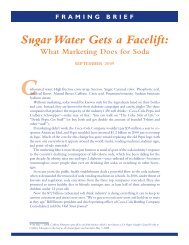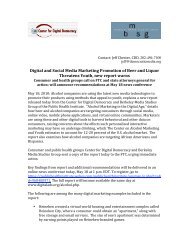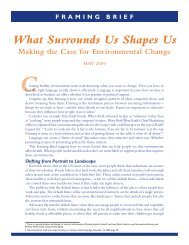"Interactive Food & Beverage Marketing" (PDF)
"Interactive Food & Beverage Marketing" (PDF)
"Interactive Food & Beverage Marketing" (PDF)
Create successful ePaper yourself
Turn your PDF publications into a flip-book with our unique Google optimized e-Paper software.
Adolescents may be<br />
even more at risk of<br />
consuming a “highcalorie,<br />
low-nutrient”<br />
diet than younger<br />
children.<br />
64<br />
<strong>Interactive</strong> <strong>Food</strong> & <strong>Beverage</strong> Marketing | Creating a Healthy Media Environment for the 21st Century<br />
The government is spearheading a number of initiatives aimed at addressing<br />
the role of food marketing in children’s heath. The Federal Trade Commission is in the<br />
midst of completing an inquiry as a follow-up to its 2005 workshop on “Marketing, Self-<br />
Regulation, and Childhood Obesity,” jointly sponsored by the Department of Health and<br />
Human Services. 283 The FTC is expected to ask a number of food and beverage and<br />
quick-service restaurant companies to provide data about their marketing practices, and<br />
will be reporting back to Congress. 284 The Federal Communications Commission’s Task<br />
Force on Media and Childhood Obesity, whose members include Senator Sam Brownback<br />
(R-Texas) and other lawmakers, the chairman of the FCC and two of its commissioners, as<br />
well as representatives of food companies, advertising groups, and nonprofit organizations,<br />
will be issuing its recommendations within the next few months. 285 The emphasis<br />
at both of these regulatory agencies is on encouraging better self-policing by the industry,<br />
rather than on proposing new government rules to guide food marketing. (The FCC has<br />
instituted some new rules to govern children’s advertising in digital broadcasting, but<br />
none specifically addresses food products.) 286<br />
The recent industry self-regulatory efforts are an indication of how seriously food<br />
and advertising corporations view the problem. But while they are steps in the right direction,<br />
they are not enough. The members of the Children’s <strong>Food</strong> and <strong>Beverage</strong> Advertising<br />
Initiative, which account for an estimated two-thirds of children’s food and beverage television<br />
advertising expenditures, has promised to<br />
devote at least half their advertising directed to children on television,<br />
radio, print and Internet to promote healthier dietary choices and/or to<br />
messages that encourage good nutrition or healthy lifestyles; limit<br />
products shown in interactive games to healthier dietary choices, or<br />
incorporate healthy lifestyles messages into games; not advertise food<br />
and beverage products in elementary schools; not engage in food and<br />
beverage product placement in editorial and entertainment content;<br />
reduce the use of third-party licensed characters in advertising that<br />
does not meet the initiative’s product or messaging criteria. 287<br />
How these commitments will translate into changes in business practices, however,<br />
is not yet clear. The revised Children’s Advertising Review Unit guidelines do include<br />
some provisions related to interactive marketing, but they are very narrow. For example,<br />
they stipulate that advertising “should not be presented in a manner that blurs the distinction<br />
between advertising and program/editorial content in ways that would be misleading<br />
to children.” And on “websites directed to children, if an advertiser integrates an<br />
advertisement into the content of a game or activity, then the advertiser should make









